
How Understanding The Calf Muscle Can Improve Sprint Performance
Calf muscles are paramount in sprint acceleration. Period.
If you think speed is mainly attributed to the powerful thighs and glutes, you might be missing a key piece of the puzzle. Acceleration—the ability to explode off the mark in those crucial meters—relies heavily on the triceps surae (calf muscles) and Achilles tendon. Yet, these muscles are often overlooked in performance training and rehab programs.
A recent study by Hébert-Losier and colleagues shows just how significant the calf muscles are for short-distance sprinting. The research looked at Rugby union players & directly links plantarflexor strength and endurance to acceleration, emphasising their importance not just for Rugby players but for any athlete needing explosive speed.
This article breaks down that study, translating complex data into practical tips for physiotherapists & strength and conditioning coaches.
Refining your approach to calf training could give your players an edge in acceleration, help prevent injuries, and optimise rehab strategies.
Read on as we dive into the details of this great study.
In A Nutshell
Rapid Results:
The study found a strong correlation between calf muscle performance (power and strength-endurance) and 10-meter sprint times in Rugby Union players. Specifically, higher metrics for weighted power, total work, and total displacement were closely linked with faster sprint acceleration
Professional takeaway:
Helping athletes understand the strong connection between calf muscle strength, power, and their ability to accelerate may help the “buy in” when delivering prehab or specific calf programmes.
Aim Of The Study
The study aims to look into the relationship between calf muscle performance—specifically power and strength-endurance metrics—and 10-meter sprint times in Rugby Union players.
It seeks to provide information for improving rehabilitation, injury prevention, and athletic performance.

Did You Know?
In Rugby Union, acceleration is fundamentally one of the main skills that can change the game in an instance.
While top-end speed might seem impressive, it’s the short, sharp bursts that really matter during crucial moments like breaking tackles, advancing meters, or scoring tries.
Studies have shown a connection between acceleration and performance metrics like line breaks and evasion, which highlights just how important it is to get up to speed quickly.
For players to deliver these powerful bursts of movement, they rely heavily on their calf muscles—the triceps surae—and the Achilles tendon.
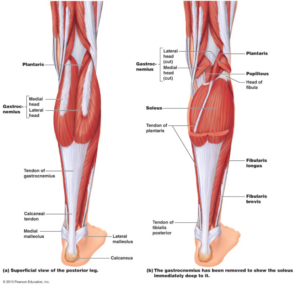
The plantorflexors produce forces up 11x body weight in steady state running and 16x body weight during accelerations.
However, as you might expect, the calf complex contributes to more than just speed and acceleration.
They are involved in pretty much every movement that Rugby demands—whether it’s jumping, landing, cutting, or slowing down after a sprint. That makes them central not just to performance but also to injury prevention.
Unfortunately, the calf muscles and Achilles tendon rank high on the list of common Rugby injuries, second only to hamstrings (same as football).
Given the heavy strain placed on these muscles during matches and training, fatigue sets in, reducing their ability to perform and increasing injury risk.
What’s interesting is how closely calf muscle performance seems tied to athletic ability.
Research suggests that the plantarflexors don’t have much room to spare—they operate near their maximum capacity during sprints and running.
As the muscles fatigue, their ability to generate power drops significantly, which affects performance.
While the connection between calf strength and general athletic performance has been looked at, we still don’t fully understand how these muscles influence abilities like sprinting and acceleration in Rugby Union specifically.
Hence, this study..
The Study
Study Design
Observational, cross-sectional, and correlational study.
- Observational Study: Researchers observe and record behaviour without manipulating any variables.
- Cross-Sectional Study: Data is collected from participants at a single point in time to examine relationships or trends.
- Correlational Study: This type of study investigates the relationship between two or more variables without determining causality.
Sample Size and Participants
A total of 16 male Rugby Union players, registered with the New Zealand Rugby Union, participated.
Inclusion criteria required players to be injury-free and medically cleared. Testing occurred over two sessions in the early morning, with all participants completing the protocols.
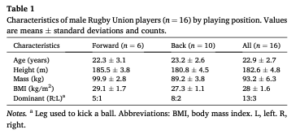
Procedures
Calf Muscle Testing: Three single-leg tests.
- Eccentric-Concentric Bodyweight Power Test: In this test, participants perform rapid calf raises by lifting both heels as high as possible while keeping one leg straight, with the goal of generating peak power during the upward (concentric) phase. The highest power achieved during three repetitions is recorded for each leg, and data from both legs are averaged.
- Eccentric-Concentric Weighted Power Test: Similar to the bodyweight test, but participants hold a 35 kg dumbbell on one shoulder while balancing with the opposite hand, focusing on generating peak power during the upward phase. The highest peak power during three repetitions is measured for each leg, with data averaged from both legs.
- Concentric-Eccentric Strength-Endurance Test: Participants perform as many single-leg calf raises as possible to a metronome rhythm, aiming for maximum repetitions while maintaining form and timing. The total number of repetitions, peak displacement, and work done are recorded, with data from both legs averaged for further analysis
They were done using the iOS Calf Raise application for precise measurement.
Markers on participants’ ankles allowed for tracking displacement via video analysis. Tests were performed barefoot on a raised box, with standardised positioning and verbal encouragement to ensure consistency.
10-Meter Sprint Testing: Sprint trials were conducted three to four days after calf tests, using timing gates on artificial turf. Players completed at least three sprints with a warm-up routine beforehand, and times were recorded to the nearest 0.01 seconds.

Results
Sprint Times and Calf Muscle Metrics
Significant correlations were observed between 10-meter sprint times and calf muscle performance metrics.
For average sprint times, strong relationships were found with calf muscle power (bodyweight and weighted) and strength-endurance metrics (total displacement and total work).
For best sprint times, significant correlations was seen with weighted power and strength-endurance metrics, including peak displacement, total displacement, and total work.
Relationships Among Calf Muscle Metrics
Exploratory analysis showed robust correlations between different calf muscle metrics.
Specifically:
- Bodyweight and weighted power were strongly correlated.
- Weighted power and strength-endurance metrics (total displacement and total work) also showed significant relationships.
- Among strength-endurance metrics, all were significantly correlated except for peak displacement and total work.
- Total displacement and total work exhibited an almost perfect correlation (r = 0.943).
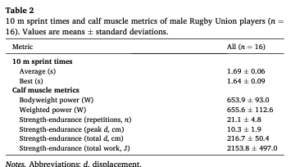
Expert Opinion
Plantarflexors in Sprint Performance
This study shows just how importnat the calf muscles are for sprinting, particularly over short distances like the 10-meter.
The researchers directly connected plantarflexor power and strength-endurance with sprint performance.
Higher metrics for weighted power, total work, and total displacement were seen to be strongly linked with both average and best sprint times.
This means that,
The calf muscles are the engine behind quick acceleration—a fundamental requirement not just for rugby players, but pretty much every explosive team based sports.
That said, these findings are not a one off.
Similar research in other sports has seen the significance of strong plantarflexors.
For example, in cricket, greater isometric plantarflexor strength has been linked to faster sprint times during simulated runs between wickets.
Additionally, research involving university students showed strong correlations between calf muscle strength and short-distance sprint times.
This consistency across various sports and groups is what makes excited. For far too long the main emphasis has been on the big boys (hammies, quads & glutes) when it comes to pretty much any return to sport and performance programmes.
For explosive team based sport (basketball, football, hurling etc) and especially Rugby players, the practical implication is clear: incorporating targeted testing and training for calf power and endurance isn’t just beneficial—it’s essential.
Why Calf Muscle Metrics Matter?
For physiotherapists and S&C coaches, the findings from this study are especially relevant.
The triceps surae muscles (gastrocnemius and soleus), are already known for their involvement movement and performance in various metrics such as jump height and reactiveness
However, this study takes it a step further by emphasising their direct link to sprint acceleration, a core element of Rugby.
For athletes recovering from injury, especially those affecting the calf muscles or Achilles tendon, restoring maximum force generation and strength-endurance is the number one priority.
Injury prevention protocols can also be tweaked based in the information from this study.
The triceps surae muscle-tendon unit is under immense stress during training and games, which makes it highly susceptible to overuse and strain-related injuries.
However, compliance with injury prevention programs often falls short because players may not fully grasp their value.
Players are more likely to stay consistent with programs when they understand how injury prevention directly translates into enhanced performance on the field.
A stronger focus on calf function could also reduce the high injury rates associated with these muscles.
Practical Testing for Professionals
Among the three testing methods for calf muscle function, the weighted power test stood out in this study.
It showed the strongest link with short sprint performance, which makes it an ideal test for assessing a player’s acceleration
Beyond its predictive accuracy, this test is also practical—it’s quick to administer and less likely to cause delayed onset muscle soreness compared to more exhaustive strength-endurance tests.
Although the current protocol uses a fixed load of 35 kilograms, future research could explore whether adjusting this load based on the persons body weight would show even more precise results.
For now, the fixed load gives a balance of simplicity and practicality, particularly when testing large groups of athletes.
In terms of muscular fatigue,
This study helps to interpret strength-endurance tests a little better.
Traditional measures, like counting repetitions or recording peak displacement, often fall short of capturing the full picture of calf muscle function.
For example, peak displacement doesn’t consider the combined effects of body mass and movement, and repetition counts ignore fatigue, range of motion, or overall work performed.
By focusing on total work, which accounts for the body mass displaced and movement efficiency, practitioners can gain a more accurate understanding of an athlete’s strength-endurance capacity.
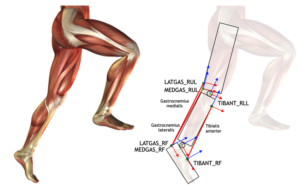
Clinical Tips
Try the Weighted Power Test
The weighted power test is a quick and effective way to assess an athlete’s calf muscle power and its relationship to sprint acceleration. You can use a standardised external load (e.g., 35 kg) for consistency, but consider body-weight-relative adjustments if individual precision is required. This test is less likely to cause delayed onset muscle soreness compared to strength-endurance testing, making it ideal for frequent monitoring of performance progress or return-to-play readiness.
Focus on Total Work Over Repetition Counts
When assessing strength-endurance, prioritise total work as the key metric. Unlike simple repetition counts or peak displacement, total work captures the combination of body mass and movement efficiency.
Education is Important
Educate athletes about the direct link between calf muscle strength, power, and acceleration. Improving plantarflexor function can enhance short sprint performance. This understanding can improve compliance with training and rehabilitation programs.
Incorporate Both Strength-Endurance and Power Exercises
Balance strength-endurance training (e.g., weighted calf raises) with power-focused exercises (e.g., explosive hops or weighted jumps). Strength-endurance enhances the calf’s ability to sustain repeated efforts, while power exercises improve the explosive force needed for acceleration and high-speed sprints. Tailor these exercises to the athlete’s sport-specific demands.
Monitor and Prevent Overuse Injuries
The triceps surae and Achilles tendon are among the most frequently injured structures in high-impact sports. Use regular testing to identify imbalances or weaknesses in calf muscle function early. Integrate targeted prehabilitation work, such as eccentric calf raises and ankle stability drills, into training programs to reduce injury risk.
References:
- Hébert-Losier, K., Balsalobre-Fernandez, C. and O’Neill, S., 2023. Calf muscle abilities are related to sprint performance in male Rugby Union players. Physical Therapy in Sport, 64, pp.117-122.
- Kulmala, J.P., Korhonen, M.T., Ruggiero, L., Kuitunen, S., Suominen, H., Heinonen, A., Mikkola, A. and Avela, J., 2016. Walking and running require greater effort from the ankle than the knee extensor muscles. Medicine & science in sports & exercise, 48(11), pp.2181-2189.
- Möck, S., Hartmann, R., Wirth, K., Rosenkranz, G. and Mickel, C., 2018. Correlation of dynamic strength in the standing calf raise with sprinting performance in consecutive sections up to 30 meters. Research in sports medicine, 26(4), pp.474-481.
- Pandy, M.G., Lai, A.K., Schache, A.G. and Lin, Y.C., 2021. How muscles maximize performance in accelerated sprinting. Scandinavian Journal of Medicine & Science in Sports, 31(10), pp.1882-1896.
- Smart, D., Hopkins, W.G., Quarrie, K.L. and Gill, N., 2014. The relationship between physical fitness and game behaviours in rugby union players. European journal of sport science, 14, pp.S8-S17.



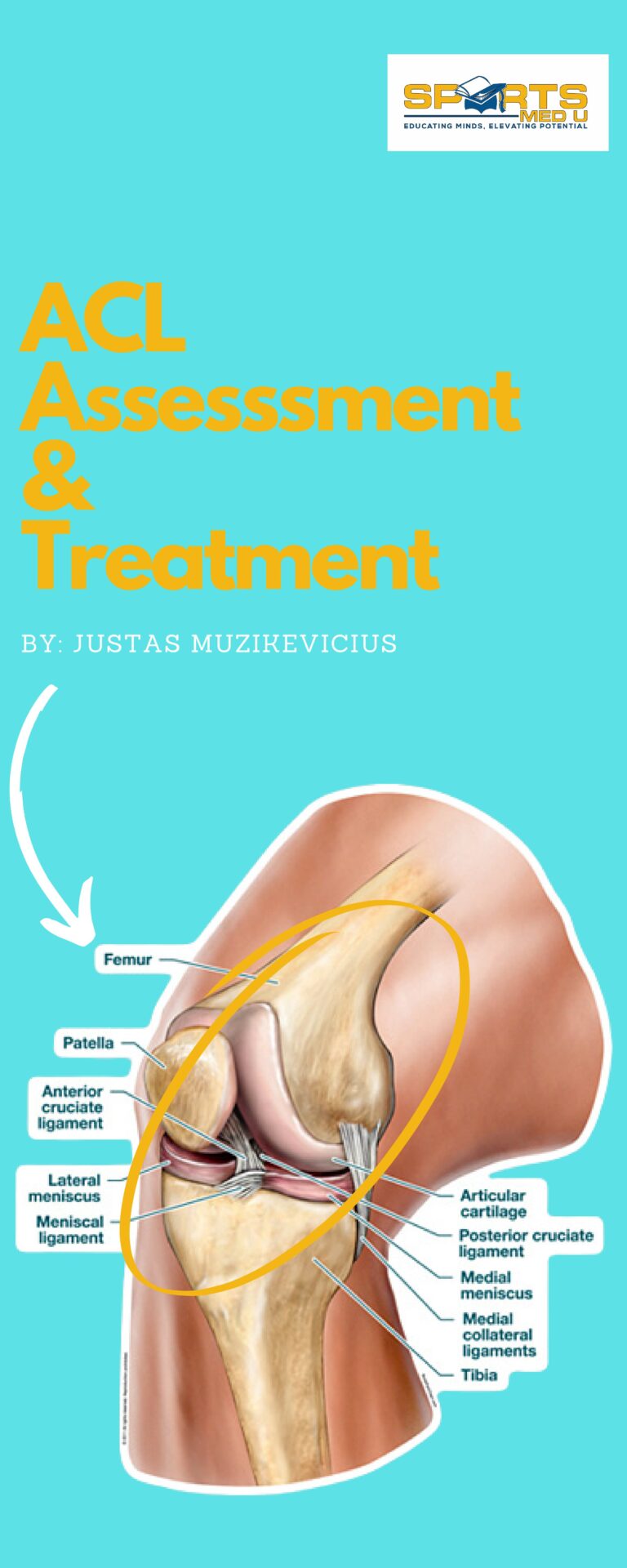




Leave a Reply